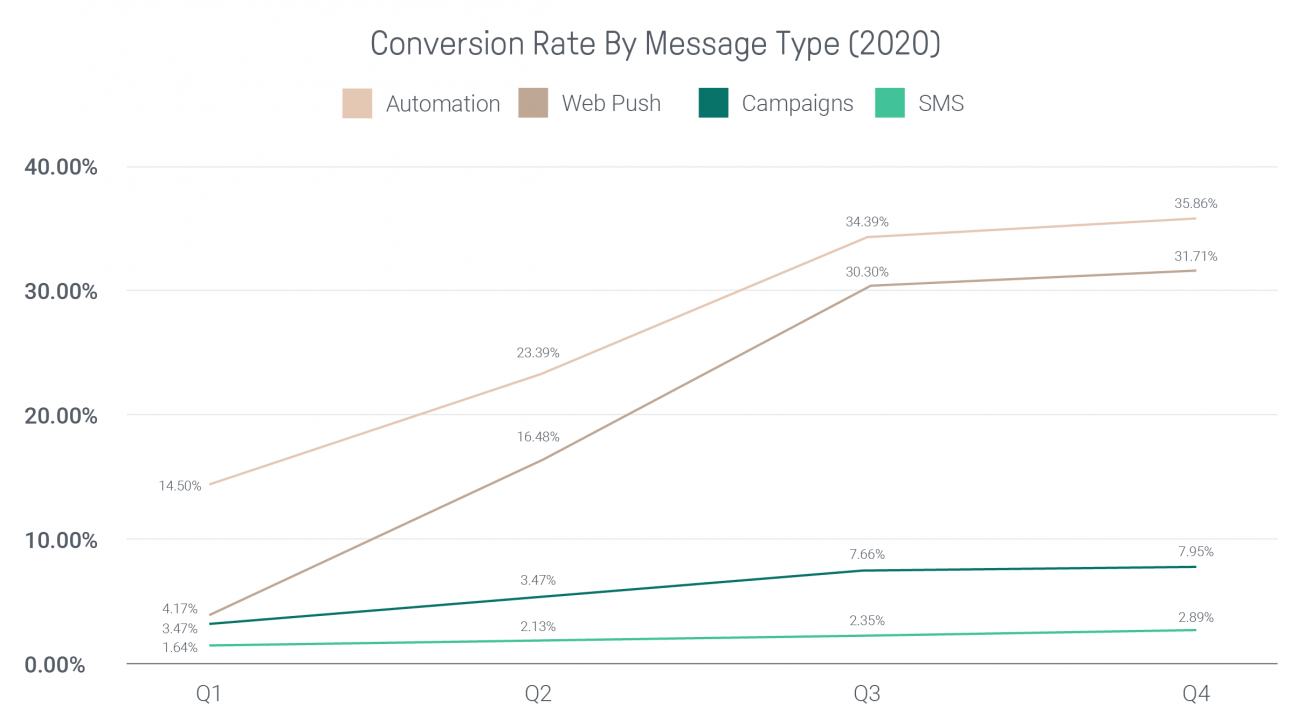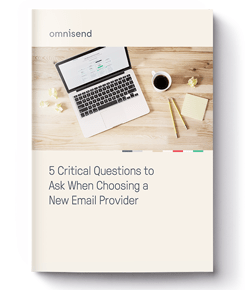What’s the first thing you look at when you’re shopping for products online? Chances are, it’s customer reviews, something that’s becoming more crucial for both customer activation and customer retention .
With digital advertising on Google, Facebook, and other social media showing declining results , customer reviews have become such an essential part of making purchase decisions—so much so that we now trust online reviews as much as we trust recommendations from our closest friends and family.
You could say that reviews have become the new ‘word of mouth’ marketing that has always been so valuable to retailers.
The good news for ecommerce businesses is that consumers find user-generated content (UGC) like customer reviews and other forms of social proof to be 35% more memorable than other media, and 50% more trusted. Combined with the fact that consumer-trusted, opt-in channels like email, SMS, and web push messages all saw a 100% year-over-year increase in conversion rate in 2020, the combination of these messages with UGC hold real power to increase customer reviews and sales.

This begs the question—are you incorporating review marketing into your overall ecommerce marketing strategy?
In this article, we’ll take a deeper look into review marketing, discussing things like the best ways to collect reviews, how and where to use customer reviews most effectively, and which tools to use to help you with your review marketing strategy.
But first, let’s find out more about the importance of social proof, and discuss what review marketing can do for your business.
Why is review marketing important for ecommerce businesses?
Social proof, simply put, is content generated by customers that shows that your brand is trustworthy.
Social proof comes in the form of things like online product reviews, ratings, unboxing videos, and social media posts. Knowing that other people have had a great experience with your products sends a powerful signal that a brand is legitimate, and a purchase can be made with confidence.
Reviews are the most common form of social proof and the easiest to collect. Actively asking your customers for reviews shows that you value their feedback, makes them feel a part of your community, and builds trust. Not only will your efforts result in increased customer loyalty, but their reviews can become valuable marketing assets in their own right!
By strategically placing selected positive reviews and testimonials throughout your store and marketing messages, you can give customers the excitement and reassurance they might need to make a purchase.
Finally, having a large number of reviews significantly affects your brand perception in relation to your competitors—we’re much more likely to trust a brand or product with 100 reviews over one with just 10. With online shopping increasing year after year, the time to start collecting them is now!
How to collect reviews and use them effectively
If you do it right, collecting reviews can become an easy and continuous process, providing you with a huge number and variety of reviews. The following best practices should be implemented to give you the best chance of success.
1. Make it as easy as possible
While customers are generally shifting towards being more positive in their reviews, there are still only 28% that are willing to write a review about a good experience.
You need to make life as easy as possible and reduce any friction in your review request process.
Provide an attractively presented, easy-to-find link in your post-purchase messaging that takes customers directly to the review site of your choice, with no extra steps or unnecessary information to distract them.
A couple of short sentences explaining why you’re asking for a review, and how you’ll find it useful, will suffice—customers will appreciate this transparency and feel included in the overall success of your business. If inclined, you can incentivize the customer to provide a review. Not only will you gather a review but you may also secure a sooner-than-expected repeat purchase.
In 2020, customer review emails generated a click rate of 22% and a conversion rate of 13% . You can find tips on creating a captivating product review message here.
A good review management tool should include multiple, easily-customizable review request templates, which you can send to customers instantly. We’ll look into tools in more detail later in this article.
2. Be on all of the major customer review websites and channels
Google, Facebook, and Amazon are a few of the go-to places, other than your website, consumers look for customer reviews. Regardless of the channel, each one has the power to convince a shopper whether or not to make a purchase.
Whether it’s Instagram, Yelp, or your own ecommerce store, staying active and replying to reviews is a key component of your review marketing strategy—especially when it comes to negative reviews. The ability to respond quickly to negative reviews shows that you value feedback and are willing to learn from your mistakes, while also giving your own side to the story.
Have a plan for responding to negative reviews so you can turn them into a positive moment of growth and learning that boosts your overall brand perception.
3. Use your reviews effectively
So you’ve collected a good amount of positive and informative reviews. Congratulations! Now it’s time to put these valuable examples of social proof to the best use. Consider displaying your best reviews in the following places:
- Social media: Turn your reviews into engaging social media posts. You can use templates, images, testimonials, and even tag the reviewer if possible, to create a conversion around the review. People generally enjoy having their voices heard, and this is a great way to show off your reviews while reaching out to a larger audience.
- Emails: Email marketing is your main revenue maker, delivering by far the highest ROI of any marketing channel, so your emails are prime real estate for showing off reviews. For brand new email subscribers or those abandoning their cart, the assurance that an attractively-presented, glowing review gives could be the nudge they need to make a purchase.
- Your website: This one is super important because many visitors to your website are coming there for the first time. Start building trust immediately by adding positive reviews on key pages such as the homepage, product pages, during checkout, or anywhere reassurance and real-life examples of the usefulness of your product are helpful. And don’t forget to include product reviews in your welcome series messaging.
- In your advertising: As we mentioned earlier, we’ve become saturated with ads, and trust in direct commercial advertising is at an all-time low. People value and trust the opinions of their peers far more, with statistics showing that ads that incorporate user-generated content receive four-times higher click-through rates. Showcase reviews and other social proof in your advertising wherever it is feasible to do so.
Useful tools to optimize your review management
Bringing it all together are some great tools that specialize in review management. Here at Omnisend, we seamlessly integrate with the following platforms to make your review marketing as easy and effective as possible.
- Yotpo offers everything an ecommerce business needs to optimize customer reviews, user-generated photos, and videos, loyalty, and referral programs. Yotpo is ideal for turning your customer content into sales and is an all-in-one solution for your social proof strategy.
- Fomo is a social proof marketing platform that specializes in showcasing things like your recent orders and product reviews on your storefront. Fomo “creates the online equivalent of a busy restaurant, showing prospective shoppers that other people trust your business.”
- Growave is an all-in-one marketing platform that’s designed to help businesses reach, engage, and convert their customers. Offering powerful tools for things like reviews, wish lists, loyalty programs, referrals, and other user-generated content, Growave has everything you need for building trust and loyalty with your customers.
- Junip helps you to capture the very best reviews, allowing you to share your customers’ stories at the center of your shop and marketing messages. Junip promises to help you build trust with genuine, in-depth reviews that incorporate photos, videos, and custom questions, all solicited automatically after purchase.
- Okendo promises to build shopper excitement and showcase customer community with high-impact reviews and attention-grabbing media galleries. This Shopify app also pushes your best reviews to platforms like Facebook and Google, allowing you to show reviews in paid and organic marketing channels like Google Ads and Google Search.
- Stamped is a great tool for enhancing user engagement, enabling you to create loyalty and rewards programs while encouraging reviews and other user-generated content. With Stamped, you can gather customer reviews with ease and share them easily on your website and other key platforms.
Review Marketing Strategies: Wrap up
Let’s face it, consumers clearly trust the opinions of their peers far more than promotional messages. Learning how to effectively generate, collect, and display user-generated content can now be the crucial difference between you and your competitors.
If you’re not proactively asking for reviews in a planned, constant cycle, you’re missing out on a treasure trove of incredibly valuable marketing assets. Reviews are one of the best and most accessible forms of social proof available, and they’ll cost you absolutely nothing!
So go ahead and try some of the tips and tools outlined in this article and start listening to your customers, interacting with their feedback, and building trust with their reviews today!
